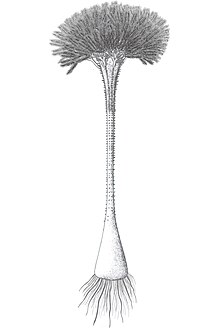→Description: more |
|||
| Line 27: | Line 27: | ||
=== Earliest known fossil forest === |
=== Earliest known fossil forest === |
||
In March 2024, [[paleontologist]]s revealed the discovery of the earliest-known fossilized forest, comprised of Calamophyton trees, in the [[Hangman Sandstone Formation]] in [[ |
In March 2024, [[paleontologist]]s revealed the discovery of the earliest-known fossilized forest, comprised of Calamophyton trees, in the [[Hangman Sandstone Formation]] in [[Minehead]], [[Somerset]], England. In the Middle Devonian period when the forest was formed, this region was adjacent to Germany and Belgium. The fossilized forest pre-dates the previously oldest-known example, a root system disovered in New York State, by about five million years. |
||
== References == |
== References == |
||
Revision as of 04:05, 18 March 2024
| Calamophyton Temporal range: Middle Devonian
| |
|---|---|

| |
| Scientific classification | |
| Kingdom: | Plantae |
| Clade: | Tracheophytes |
| Division: | Pteridophyta (?) |
| Class: | †Cladoxylopsida |
| Order: | †Pseudosporochnales |
| Family: | †Hyeniaceae |
| Genus: | †Calamophyton R.Kräusel & H.Weyland, 1925 |
| Species | |
| |
Calamophyton is an extinct genus of tree, or "tree-sized plant",[1] that was extant in the Middle Devonian period. Calamophyton trees formed the earliest known forests.[2]
Discovery
The genus was established in 1926 from specimens collected by R. Kräusel & H. Weyland, in Hardberg and Kirberg, Rhineland, Germany, who identified the type species C. primaevum.[3] A second species, C. renierii, was identified by S. Leclercq in Belgium in 1940, a third, C. bicephalum, also in Belgium, by Leclerqc and H. Andrews in 1960,[3] and a fourth, C. forbesii, in the Mapleton Sandstone, Maine, United States, by James M. Schopf in 1964.[4] It has since been suggested that C. primaevum and C. bicephalum may be the same species. All samples date to the Middle Devonian.
Description
The genus has been described as having an unusual morphology. Specimens are between 0.8 and 4 metres in height. The trunks were hollow in the centre, and supported on the outside by strands of wood-like material. These strands would weaken as the tree increased in height, causing the upper part of the trunk to split apart, thus limiting the tree's overall height. Branches grew only at the top, so that as the trunk grew, the lower branches would be shed. The branches did not have leaves, but rather "twig-like structures" that performed photosynthesis.
Earliest known fossil forest
In March 2024, paleontologists revealed the discovery of the earliest-known fossilized forest, comprised of Calamophyton trees, in the Hangman Sandstone Formation in Minehead, Somerset, England. In the Middle Devonian period when the forest was formed, this region was adjacent to Germany and Belgium. The fossilized forest pre-dates the previously oldest-known example, a root system disovered in New York State, by about five million years.
References
- ^ Giesen, Peter; Berry, Christopher M. "Reconstruction and Growth of the Early Tree Calamophyton (Pseudosporochnales, Cladoxylopsida) Based on Exceptionally Complete Specimens from Lindlar, Germany (Mid-Devonian): Organic Connection of Calamophyton Branches and Duisbergia Trunks". The University of Chicago Press Journals. University of Chicago. doi:10.1086/669913. Retrieved 17 March 2024.
- ^ Devlin, Hannah (7 March 2024). "World's oldest fossilised trees discovered along Devon and Somerset coast". The Guardian. Guardian News & Media Limited. Retrieved 17 March 2024.
- ^ a b Leclercq, Suzanne; Andrews, Henry N. Jr. (Feb 1960). "Calamophyton bicephalum, a New Species from the Middle Devonian of Belgium". Annals of the Missouri Botanical Garden. 47 (1): 2. doi:10.2307/2394614.
- ^ Kasper, Andrew E. Jr; Gensel, Patricia G.; Forbes, William H.; Andrews, Henry N. Jr. "Plant Paleontology in the State of Maine - A Review". digitalmaine.com. Maine Geological Survey. Retrieved 18 March 2024.